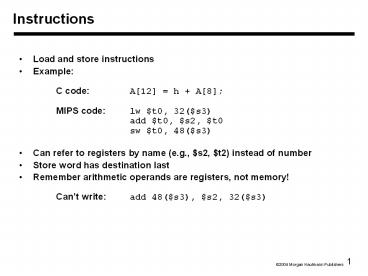Instructions - PowerPoint PPT Presentation
Title:
Instructions
Description:
Instructions – PowerPoint PPT presentation
Number of Views:28
Avg rating:3.0/5.0
Title: Instructions
1
Instructions
- Load and store instructions
- Example C code A12 h A8 MIPS
code lw t0, 32(s3) add t0, s2, t0 sw
t0, 48(s3) - Can refer to registers by name (e.g., s2, t2)
instead of number - Store word has destination last
- Remember arithmetic operands are registers, not
memory! Cant write add 48(s3), s2,
32(s3)
2
Our First Example
- Can we figure out the code?
swap(int v, int k) int temp temp
vk vk vk1 vk1 temp
swap muli 2, 5, 4 add 2, 4, 2 lw 15,
0(2) lw 16, 4(2) sw 16, 0(2) sw 15,
4(2) jr 31
3
So far weve learned
- MIPS loading words but addressing bytes
arithmetic on registers only - Instruction Meaningadd s1, s2, s3 s1
s2 s3sub s1, s2, s3 s1 s2 s3lw
s1, 100(s2) s1 Memorys2100 sw s1,
100(s2) Memorys2100 s1
4
Machine Language
- Instructions, like registers and words of data,
are also 32 bits long - Example add t1, s1, s2
- registers have numbers, t19, s117, s218
- Instruction Format 000000 10001 10010 01000 000
00 100000 op rs rt rd shamt funct - Can you guess what the field names stand for?
5
Machine Language
- Consider the load-word and store-word
instructions, - What would the regularity principle have us do?
- New principle Good design demands a compromise
- Introduce a new type of instruction format
- I-type for data transfer instructions
- other format was R-type for register
- Example lw t0, 32(s2) 35 18 9
32 op rs rt 16 bit number - Where's the compromise?
6
Stored Program Concept
- Instructions are bits
- Programs are stored in memory to be read or
written just like data - Fetch Execute Cycle
- Instructions are fetched and put into a special
register - Bits in the register "control" the subsequent
actions - Fetch the next instruction and continue
memory for data, programs, compilers, editors,
etc.
7
Control
- Decision making instructions
- alter the control flow,
- i.e., change the "next" instruction to be
executed - MIPS conditional branch instructions bne t0,
t1, Label beq t0, t1, Label - Example if (ij) h i j bne s0, s1,
Label add s3, s0, s1 Label ....
8
Control
- MIPS unconditional branch instructions j label
- Example if (i!j) beq s4, s5, Lab1
hij add s3, s4, s5 else j Lab2
hi-j Lab1 sub s3, s4, s5 Lab2 ... - Can you build a simple for loop?
9
So far
- Instruction Meaningadd s1,s2,s3 s1 s2
s3sub s1,s2,s3 s1 s2 s3lw
s1,100(s2) s1 Memorys2100 sw
s1,100(s2) Memorys2100 s1bne
s4,s5,L Next instr. is at Label if s4 ?
s5beq s4,s5,L Next instr. is at Label if s4
s5j Label Next instr. is at Label - Formats
R I J
10
Control Flow
- We have beq, bne, what about Branch-if-less-than
? - New instruction if s1 lt s2 then
t0 1 slt t0, s1, s2 else t0
0 - Can use this instruction to build "blt s1, s2,
Label" can now build general control
structures - Note that the assembler needs a register to do
this, there are policy of use conventions for
registers
11
Policy of Use Conventions
Register 1 (at) reserved for assembler, 26-27
for operating system
12
Constants
- Small constants are used quite frequently (50 of
operands) e.g., A A 5 B B 1 C
C - 18 - Solutions? Why not?
- put 'typical constants' in memory and load them.
- create hard-wired registers (like zero) for
constants like one. - MIPS Instructions addi 29, 29, 4 slti 8,
18, 10 andi 29, 29, 6 ori 29, 29, 4 - Design Principle Make the common case fast.
Which format?
13
How about larger constants?
- We'd like to be able to load a 32 bit constant
into a register - Must use two instructions, new "load upper
immediate" instruction lui t0,
1010101010101010 - Then must get the lower order bits right,
i.e., ori t0, t0, 1010101010101010
1010101010101010
0000000000000000
0000000000000000
1010101010101010
ori
14
Assembly Language vs. Machine Language
- Assembly provides convenient symbolic
representation - much easier than writing down numbers
- e.g., destination first
- Machine language is the underlying reality
- e.g., destination is no longer first
- Assembly can provide 'pseudoinstructions'
- e.g., move t0, t1 exists only in Assembly
- would be implemented using add t0,t1,zero
- When considering performance you should count
real instructions
15
Other Issues
- Discussed in your assembly language programming
lab support for procedures linkers, loaders,
memory layout stacks, frames, recursion manipula
ting strings and pointers interrupts and
exceptions system calls and conventions - Some of these we'll talk more about later
- Well talk about compiler optimizations when we
hit chapter 4.
16
Overview of MIPS
- simple instructions all 32 bits wide
- very structured, no unnecessary baggage
- only three instruction formats
- rely on compiler to achieve performance what
are the compiler's goals? - help compiler where we can
op rs rt rd shamt funct
R I J
op rs rt 16 bit address
op 26 bit address
17
Addresses in Branches and Jumps
- Instructions
- bne t4,t5,Label Next instruction is at Label
if t4 t5 - beq t4,t5,Label Next instruction is at Label
if t4 t5 - j Label Next instruction is at Label
- Formats
- Addresses are not 32 bits How do we handle
this with load and store instructions?
op rs rt 16 bit address
I J
op 26 bit address































